Cardiff Uni: Review of Autologous Venous Harvesting in CABG
VerifiedAdded on 2021/04/17
|45
|16474
|29
Report
AI Summary
This BSc dissertation from Cardiff University examines autologous venous harvesting in Coronary Artery Bypass Graft (CABG). The report reviews and compares endoscopic vein harvesting (EVH) and open vein harvesting (OVH) techniques, focusing on their effectiveness in reducing long-term complications. The introduction provides background on coronary artery disease and CABG, followed by a methodology section detailing the search strategy and PICO procedure used to analyze literature. The results section, including a PRISMA chart, presents findings from secondary sources, highlighting complications associated with EVH and OVH. The discussion analyzes the technical aspects, outcomes, and controversies associated with EVH, including vein graft patency, postoperative risks, and patient satisfaction. The report also addresses limitations, offers recommendations, and concludes with a summary of the findings. The study emphasizes the importance of considering both short-term safety and long-term outcomes when choosing between EVH and OVH, referencing various clinical studies and meta-analyses to support its conclusions. The report also examines the impact of EVH on infection rates and patient outcomes, providing a comprehensive overview of the current state of autologous vein harvesting in CABG procedures.
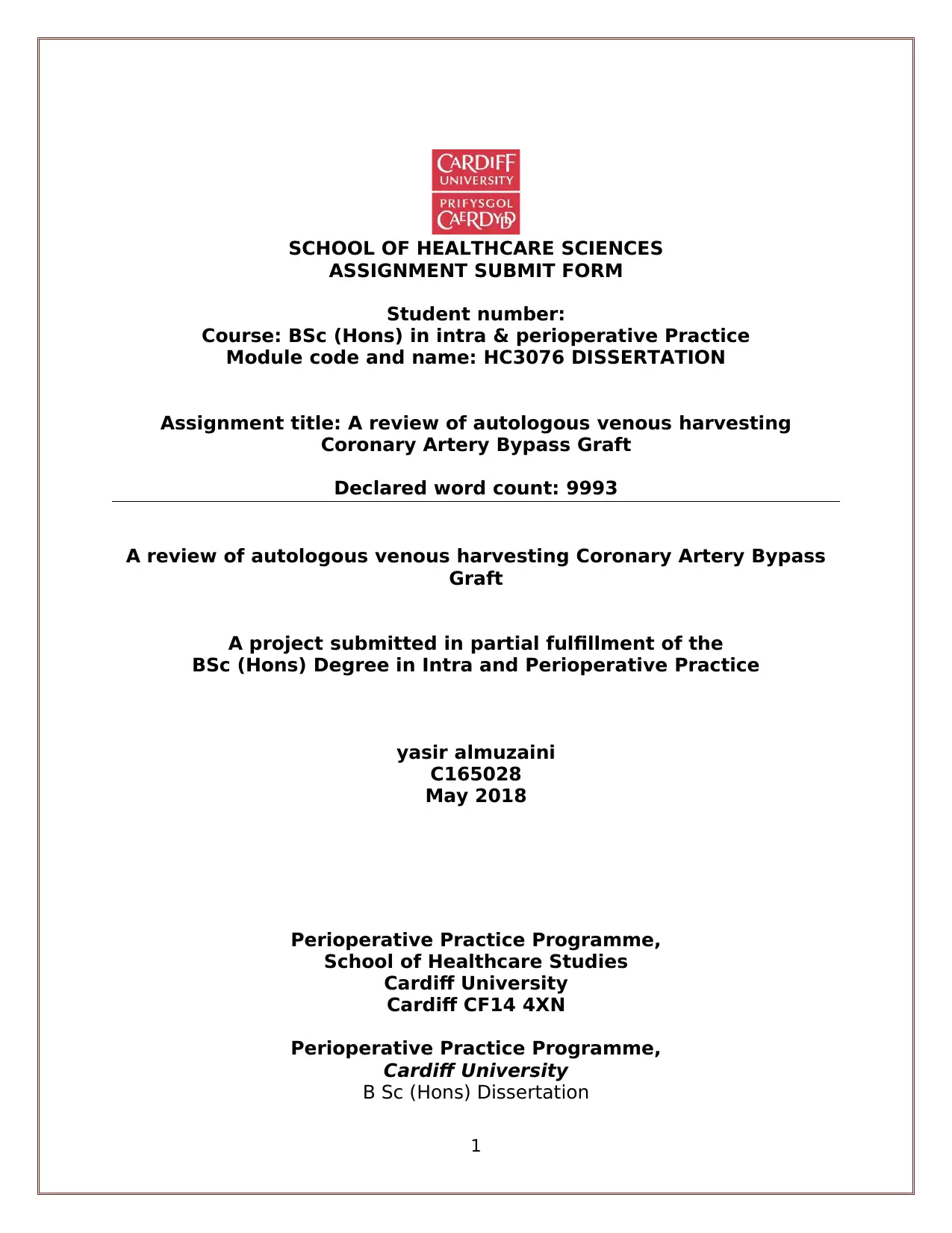
SCHOOL OF HEALTHCARE SCIENCES
ASSIGNMENT SUBMIT FORM
Student number:
Course: BSc (Hons) in intra & perioperative Practice
Module code and name: HC3076 DISSERTATION
Assignment title: A review of autologous venous harvesting
Coronary Artery Bypass Graft
Declared word count: 9993
A review of autologous venous harvesting Coronary Artery Bypass
Graft
A project submitted in partial fulfillment of the
BSc (Hons) Degree in Intra and Perioperative Practice
yasir almuzaini
C165028
May 2018
Perioperative Practice Programme,
School of Healthcare Studies
Cardiff University
Cardiff CF14 4XN
Perioperative Practice Programme,
Cardiff University
B Sc (Hons) Dissertation
1
ASSIGNMENT SUBMIT FORM
Student number:
Course: BSc (Hons) in intra & perioperative Practice
Module code and name: HC3076 DISSERTATION
Assignment title: A review of autologous venous harvesting
Coronary Artery Bypass Graft
Declared word count: 9993
A review of autologous venous harvesting Coronary Artery Bypass
Graft
A project submitted in partial fulfillment of the
BSc (Hons) Degree in Intra and Perioperative Practice
yasir almuzaini
C165028
May 2018
Perioperative Practice Programme,
School of Healthcare Studies
Cardiff University
Cardiff CF14 4XN
Perioperative Practice Programme,
Cardiff University
B Sc (Hons) Dissertation
1
Paraphrase This Document
Need a fresh take? Get an instant paraphrase of this document with our AI Paraphraser
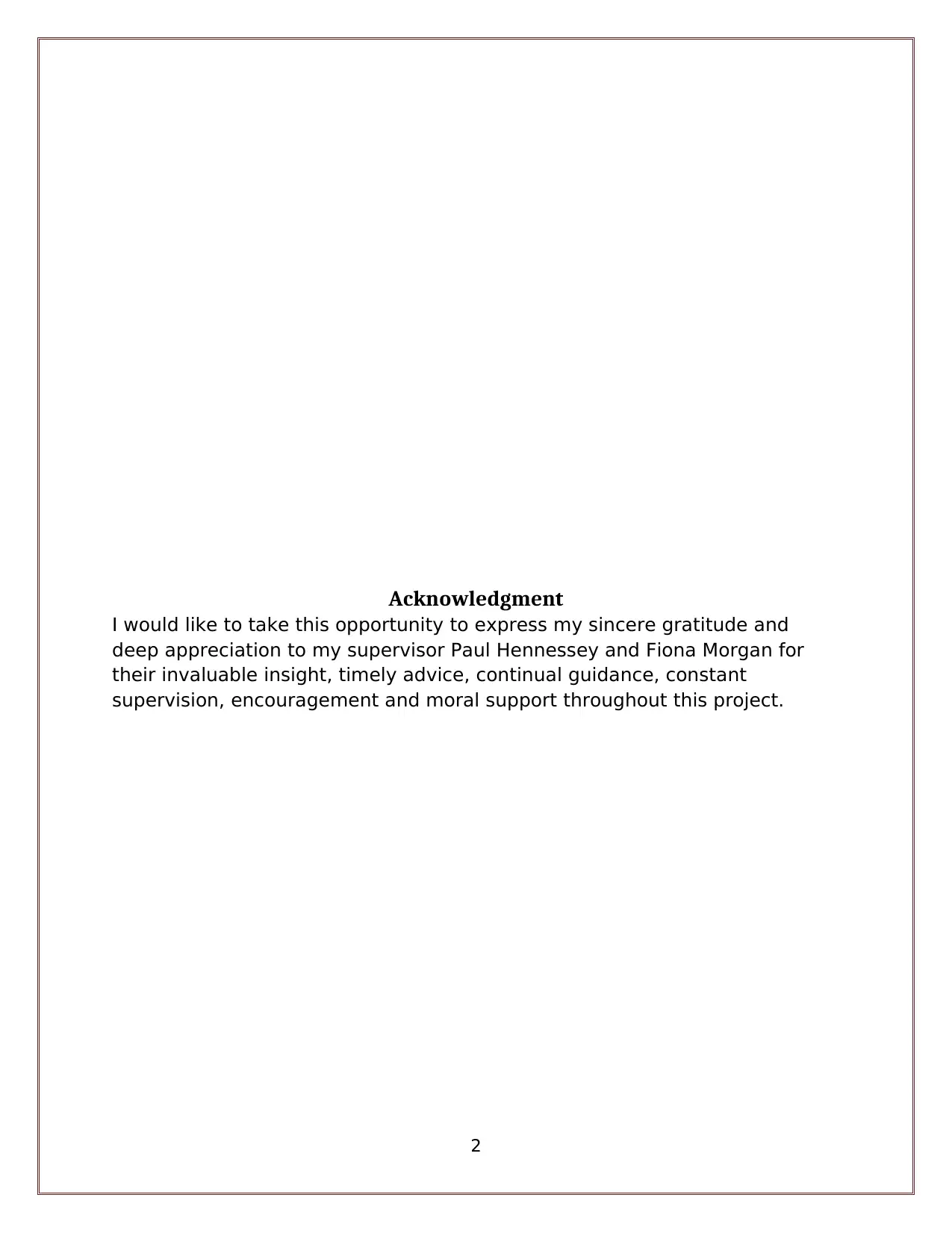
Acknowledgment
I would like to take this opportunity to express my sincere gratitude and
deep appreciation to my supervisor Paul Hennessey and Fiona Morgan for
their invaluable insight, timely advice, continual guidance, constant
supervision, encouragement and moral support throughout this project.
2
I would like to take this opportunity to express my sincere gratitude and
deep appreciation to my supervisor Paul Hennessey and Fiona Morgan for
their invaluable insight, timely advice, continual guidance, constant
supervision, encouragement and moral support throughout this project.
2
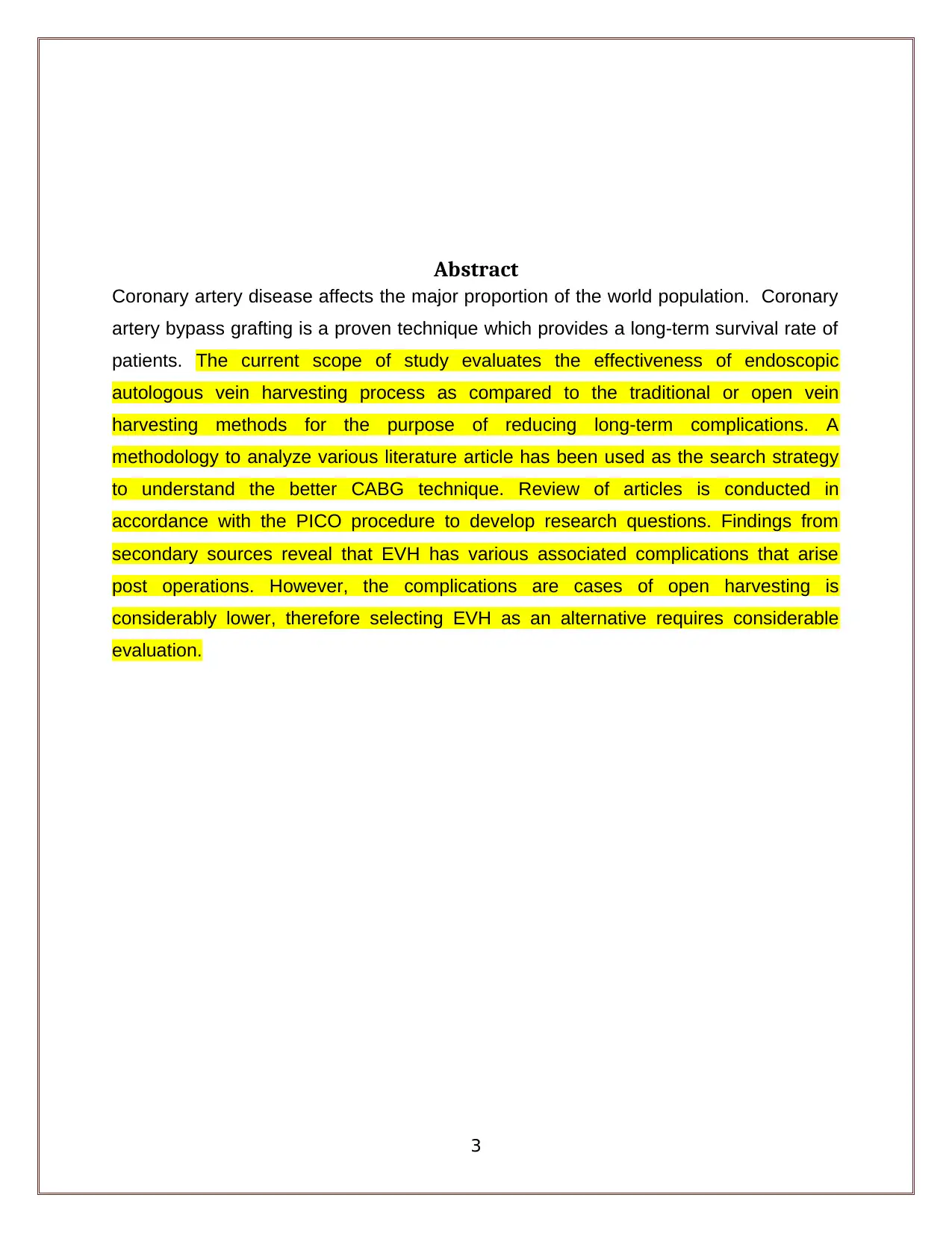
Abstract
Coronary artery disease affects the major proportion of the world population. Coronary
artery bypass grafting is a proven technique which provides a long-term survival rate of
patients. The current scope of study evaluates the effectiveness of endoscopic
autologous vein harvesting process as compared to the traditional or open vein
harvesting methods for the purpose of reducing long-term complications. A
methodology to analyze various literature article has been used as the search strategy
to understand the better CABG technique. Review of articles is conducted in
accordance with the PICO procedure to develop research questions. Findings from
secondary sources reveal that EVH has various associated complications that arise
post operations. However, the complications are cases of open harvesting is
considerably lower, therefore selecting EVH as an alternative requires considerable
evaluation.
3
Coronary artery disease affects the major proportion of the world population. Coronary
artery bypass grafting is a proven technique which provides a long-term survival rate of
patients. The current scope of study evaluates the effectiveness of endoscopic
autologous vein harvesting process as compared to the traditional or open vein
harvesting methods for the purpose of reducing long-term complications. A
methodology to analyze various literature article has been used as the search strategy
to understand the better CABG technique. Review of articles is conducted in
accordance with the PICO procedure to develop research questions. Findings from
secondary sources reveal that EVH has various associated complications that arise
post operations. However, the complications are cases of open harvesting is
considerably lower, therefore selecting EVH as an alternative requires considerable
evaluation.
3
⊘ This is a preview!⊘
Do you want full access?
Subscribe today to unlock all pages.

Trusted by 1+ million students worldwide
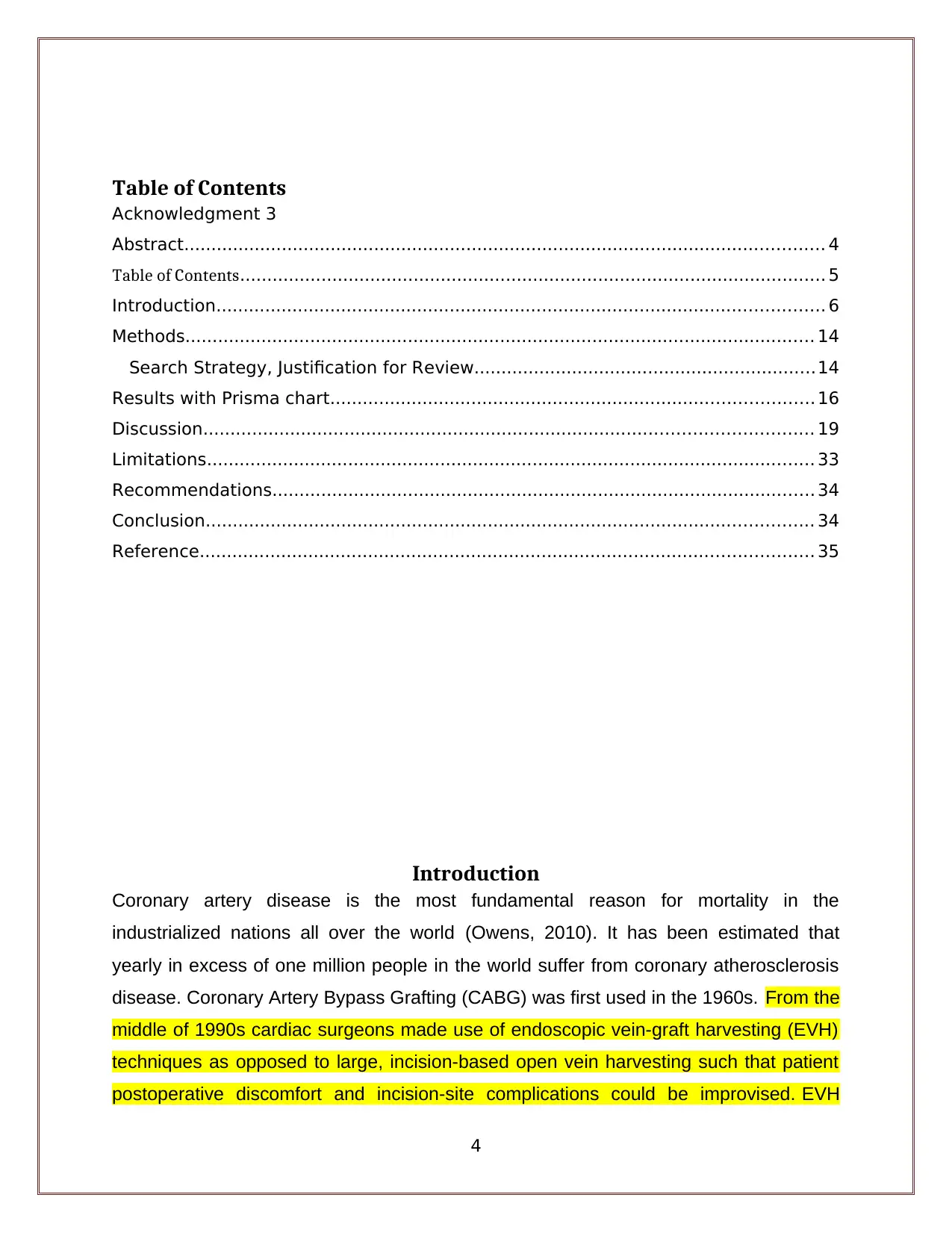
Table of Contents
Acknowledgment 3
Abstract...................................................................................................................... 4
Table of Contents............................................................................................................ 5
Introduction................................................................................................................ 6
Methods.................................................................................................................... 14
Search Strategy, Justification for Review...............................................................14
Results with Prisma chart......................................................................................... 16
Discussion................................................................................................................ 19
Limitations................................................................................................................ 33
Recommendations.................................................................................................... 34
Conclusion................................................................................................................ 34
Reference................................................................................................................. 35
Introduction
Coronary artery disease is the most fundamental reason for mortality in the
industrialized nations all over the world (Owens, 2010). It has been estimated that
yearly in excess of one million people in the world suffer from coronary atherosclerosis
disease. Coronary Artery Bypass Grafting (CABG) was first used in the 1960s. From the
middle of 1990s cardiac surgeons made use of endoscopic vein-graft harvesting (EVH)
techniques as opposed to large, incision-based open vein harvesting such that patient
postoperative discomfort and incision-site complications could be improvised. EVH
4
Acknowledgment 3
Abstract...................................................................................................................... 4
Table of Contents............................................................................................................ 5
Introduction................................................................................................................ 6
Methods.................................................................................................................... 14
Search Strategy, Justification for Review...............................................................14
Results with Prisma chart......................................................................................... 16
Discussion................................................................................................................ 19
Limitations................................................................................................................ 33
Recommendations.................................................................................................... 34
Conclusion................................................................................................................ 34
Reference................................................................................................................. 35
Introduction
Coronary artery disease is the most fundamental reason for mortality in the
industrialized nations all over the world (Owens, 2010). It has been estimated that
yearly in excess of one million people in the world suffer from coronary atherosclerosis
disease. Coronary Artery Bypass Grafting (CABG) was first used in the 1960s. From the
middle of 1990s cardiac surgeons made use of endoscopic vein-graft harvesting (EVH)
techniques as opposed to large, incision-based open vein harvesting such that patient
postoperative discomfort and incision-site complications could be improvised. EVH
4
Paraphrase This Document
Need a fresh take? Get an instant paraphrase of this document with our AI Paraphraser
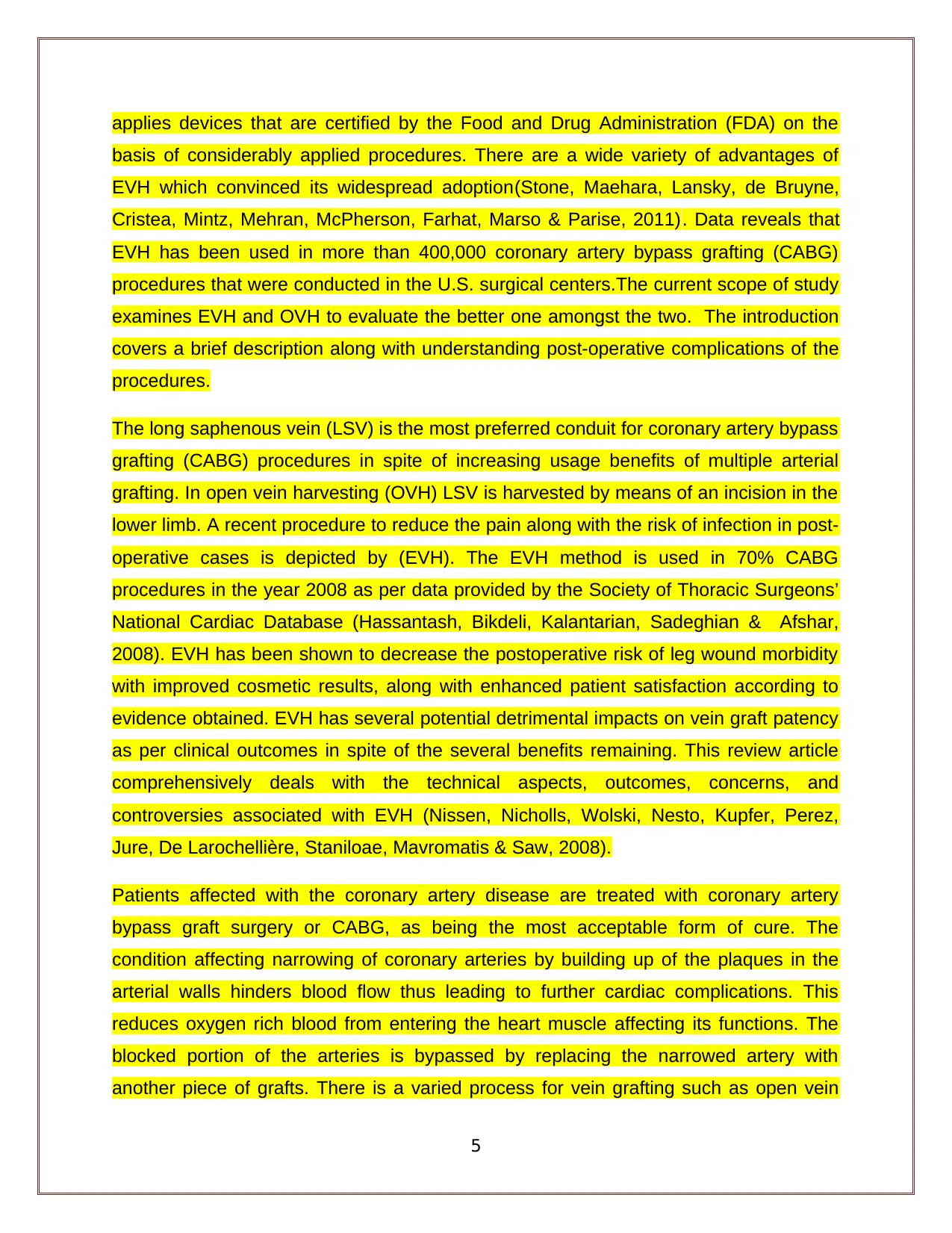
applies devices that are certified by the Food and Drug Administration (FDA) on the
basis of considerably applied procedures. There are a wide variety of advantages of
EVH which convinced its widespread adoption(Stone, Maehara, Lansky, de Bruyne,
Cristea, Mintz, Mehran, McPherson, Farhat, Marso & Parise, 2011). Data reveals that
EVH has been used in more than 400,000 coronary artery bypass grafting (CABG)
procedures that were conducted in the U.S. surgical centers.The current scope of study
examines EVH and OVH to evaluate the better one amongst the two. The introduction
covers a brief description along with understanding post-operative complications of the
procedures.
The long saphenous vein (LSV) is the most preferred conduit for coronary artery bypass
grafting (CABG) procedures in spite of increasing usage benefits of multiple arterial
grafting. In open vein harvesting (OVH) LSV is harvested by means of an incision in the
lower limb. A recent procedure to reduce the pain along with the risk of infection in post-
operative cases is depicted by (EVH). The EVH method is used in 70% CABG
procedures in the year 2008 as per data provided by the Society of Thoracic Surgeons’
National Cardiac Database (Hassantash, Bikdeli, Kalantarian, Sadeghian & Afshar,
2008). EVH has been shown to decrease the postoperative risk of leg wound morbidity
with improved cosmetic results, along with enhanced patient satisfaction according to
evidence obtained. EVH has several potential detrimental impacts on vein graft patency
as per clinical outcomes in spite of the several benefits remaining. This review article
comprehensively deals with the technical aspects, outcomes, concerns, and
controversies associated with EVH (Nissen, Nicholls, Wolski, Nesto, Kupfer, Perez,
Jure, De Larochellière, Staniloae, Mavromatis & Saw, 2008).
Patients affected with the coronary artery disease are treated with coronary artery
bypass graft surgery or CABG, as being the most acceptable form of cure. The
condition affecting narrowing of coronary arteries by building up of the plaques in the
arterial walls hinders blood flow thus leading to further cardiac complications. This
reduces oxygen rich blood from entering the heart muscle affecting its functions. The
blocked portion of the arteries is bypassed by replacing the narrowed artery with
another piece of grafts. There is a varied process for vein grafting such as open vein
5
basis of considerably applied procedures. There are a wide variety of advantages of
EVH which convinced its widespread adoption(Stone, Maehara, Lansky, de Bruyne,
Cristea, Mintz, Mehran, McPherson, Farhat, Marso & Parise, 2011). Data reveals that
EVH has been used in more than 400,000 coronary artery bypass grafting (CABG)
procedures that were conducted in the U.S. surgical centers.The current scope of study
examines EVH and OVH to evaluate the better one amongst the two. The introduction
covers a brief description along with understanding post-operative complications of the
procedures.
The long saphenous vein (LSV) is the most preferred conduit for coronary artery bypass
grafting (CABG) procedures in spite of increasing usage benefits of multiple arterial
grafting. In open vein harvesting (OVH) LSV is harvested by means of an incision in the
lower limb. A recent procedure to reduce the pain along with the risk of infection in post-
operative cases is depicted by (EVH). The EVH method is used in 70% CABG
procedures in the year 2008 as per data provided by the Society of Thoracic Surgeons’
National Cardiac Database (Hassantash, Bikdeli, Kalantarian, Sadeghian & Afshar,
2008). EVH has been shown to decrease the postoperative risk of leg wound morbidity
with improved cosmetic results, along with enhanced patient satisfaction according to
evidence obtained. EVH has several potential detrimental impacts on vein graft patency
as per clinical outcomes in spite of the several benefits remaining. This review article
comprehensively deals with the technical aspects, outcomes, concerns, and
controversies associated with EVH (Nissen, Nicholls, Wolski, Nesto, Kupfer, Perez,
Jure, De Larochellière, Staniloae, Mavromatis & Saw, 2008).
Patients affected with the coronary artery disease are treated with coronary artery
bypass graft surgery or CABG, as being the most acceptable form of cure. The
condition affecting narrowing of coronary arteries by building up of the plaques in the
arterial walls hinders blood flow thus leading to further cardiac complications. This
reduces oxygen rich blood from entering the heart muscle affecting its functions. The
blocked portion of the arteries is bypassed by replacing the narrowed artery with
another piece of grafts. There is a varied process for vein grafting such as open vein
5
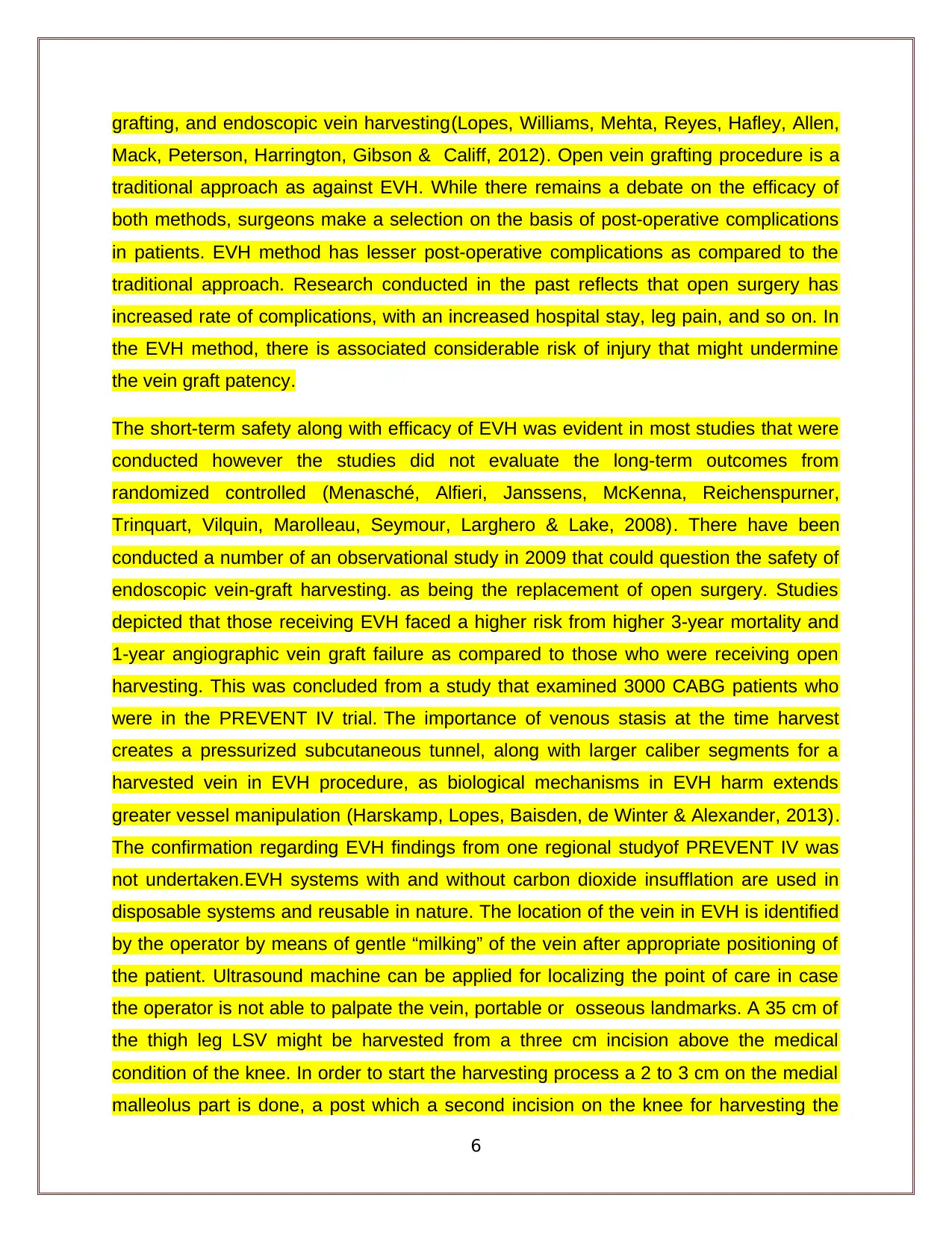
grafting, and endoscopic vein harvesting(Lopes, Williams, Mehta, Reyes, Hafley, Allen,
Mack, Peterson, Harrington, Gibson & Califf, 2012). Open vein grafting procedure is a
traditional approach as against EVH. While there remains a debate on the efficacy of
both methods, surgeons make a selection on the basis of post-operative complications
in patients. EVH method has lesser post-operative complications as compared to the
traditional approach. Research conducted in the past reflects that open surgery has
increased rate of complications, with an increased hospital stay, leg pain, and so on. In
the EVH method, there is associated considerable risk of injury that might undermine
the vein graft patency.
The short-term safety along with efficacy of EVH was evident in most studies that were
conducted however the studies did not evaluate the long-term outcomes from
randomized controlled (Menasché, Alfieri, Janssens, McKenna, Reichenspurner,
Trinquart, Vilquin, Marolleau, Seymour, Larghero & Lake, 2008). There have been
conducted a number of an observational study in 2009 that could question the safety of
endoscopic vein-graft harvesting. as being the replacement of open surgery. Studies
depicted that those receiving EVH faced a higher risk from higher 3-year mortality and
1-year angiographic vein graft failure as compared to those who were receiving open
harvesting. This was concluded from a study that examined 3000 CABG patients who
were in the PREVENT IV trial. The importance of venous stasis at the time harvest
creates a pressurized subcutaneous tunnel, along with larger caliber segments for a
harvested vein in EVH procedure, as biological mechanisms in EVH harm extends
greater vessel manipulation (Harskamp, Lopes, Baisden, de Winter & Alexander, 2013).
The confirmation regarding EVH findings from one regional studyof PREVENT IV was
not undertaken.EVH systems with and without carbon dioxide insufflation are used in
disposable systems and reusable in nature. The location of the vein in EVH is identified
by the operator by means of gentle “milking” of the vein after appropriate positioning of
the patient. Ultrasound machine can be applied for localizing the point of care in case
the operator is not able to palpate the vein, portable or osseous landmarks. A 35 cm of
the thigh leg LSV might be harvested from a three cm incision above the medical
condition of the knee. In order to start the harvesting process a 2 to 3 cm on the medial
malleolus part is done, a post which a second incision on the knee for harvesting the
6
Mack, Peterson, Harrington, Gibson & Califf, 2012). Open vein grafting procedure is a
traditional approach as against EVH. While there remains a debate on the efficacy of
both methods, surgeons make a selection on the basis of post-operative complications
in patients. EVH method has lesser post-operative complications as compared to the
traditional approach. Research conducted in the past reflects that open surgery has
increased rate of complications, with an increased hospital stay, leg pain, and so on. In
the EVH method, there is associated considerable risk of injury that might undermine
the vein graft patency.
The short-term safety along with efficacy of EVH was evident in most studies that were
conducted however the studies did not evaluate the long-term outcomes from
randomized controlled (Menasché, Alfieri, Janssens, McKenna, Reichenspurner,
Trinquart, Vilquin, Marolleau, Seymour, Larghero & Lake, 2008). There have been
conducted a number of an observational study in 2009 that could question the safety of
endoscopic vein-graft harvesting. as being the replacement of open surgery. Studies
depicted that those receiving EVH faced a higher risk from higher 3-year mortality and
1-year angiographic vein graft failure as compared to those who were receiving open
harvesting. This was concluded from a study that examined 3000 CABG patients who
were in the PREVENT IV trial. The importance of venous stasis at the time harvest
creates a pressurized subcutaneous tunnel, along with larger caliber segments for a
harvested vein in EVH procedure, as biological mechanisms in EVH harm extends
greater vessel manipulation (Harskamp, Lopes, Baisden, de Winter & Alexander, 2013).
The confirmation regarding EVH findings from one regional studyof PREVENT IV was
not undertaken.EVH systems with and without carbon dioxide insufflation are used in
disposable systems and reusable in nature. The location of the vein in EVH is identified
by the operator by means of gentle “milking” of the vein after appropriate positioning of
the patient. Ultrasound machine can be applied for localizing the point of care in case
the operator is not able to palpate the vein, portable or osseous landmarks. A 35 cm of
the thigh leg LSV might be harvested from a three cm incision above the medical
condition of the knee. In order to start the harvesting process a 2 to 3 cm on the medial
malleolus part is done, a post which a second incision on the knee for harvesting the
6
⊘ This is a preview!⊘
Do you want full access?
Subscribe today to unlock all pages.

Trusted by 1+ million students worldwide
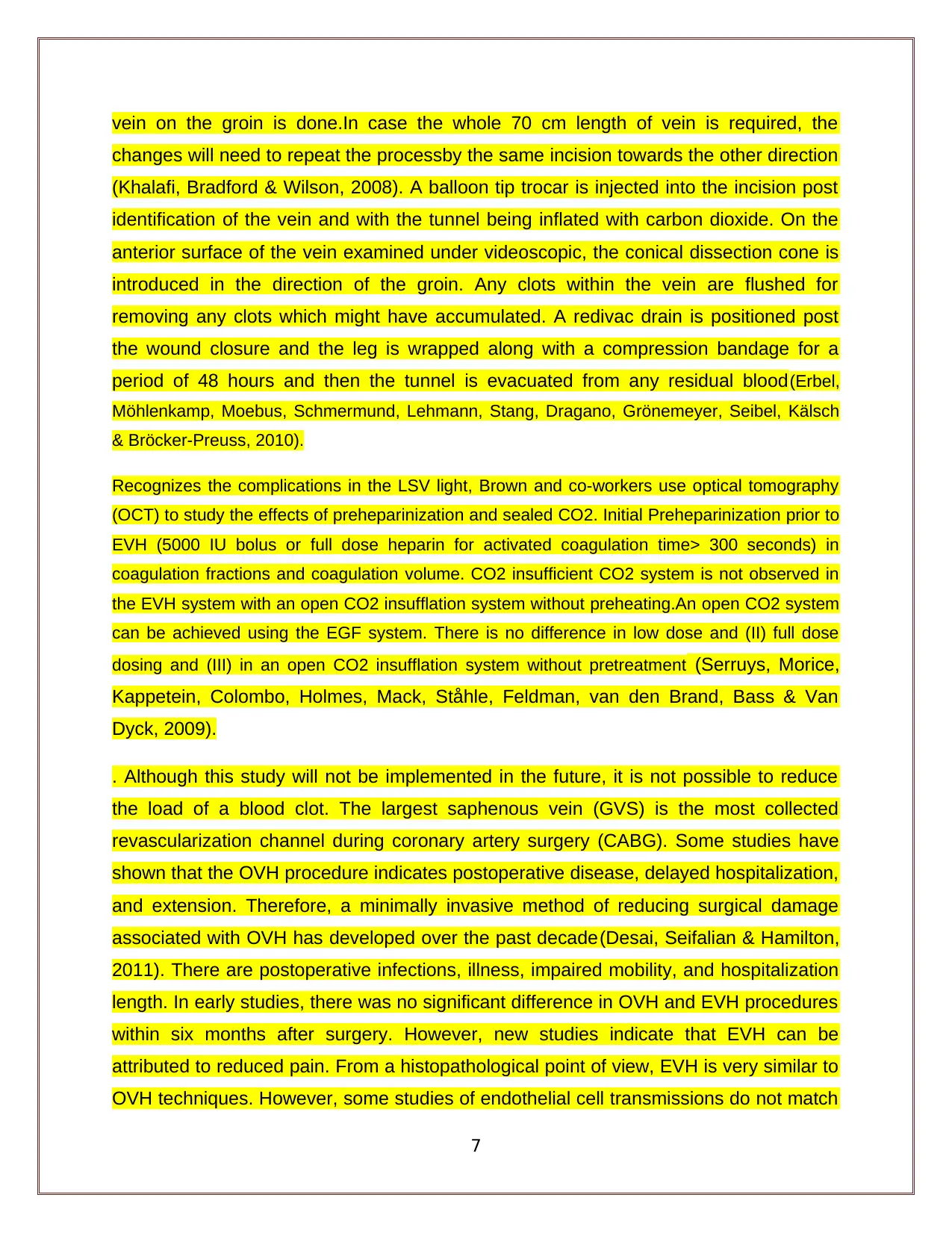
vein on the groin is done.In case the whole 70 cm length of vein is required, the
changes will need to repeat the processby the same incision towards the other direction
(Khalafi, Bradford & Wilson, 2008). A balloon tip trocar is injected into the incision post
identification of the vein and with the tunnel being inflated with carbon dioxide. On the
anterior surface of the vein examined under videoscopic, the conical dissection cone is
introduced in the direction of the groin. Any clots within the vein are flushed for
removing any clots which might have accumulated. A redivac drain is positioned post
the wound closure and the leg is wrapped along with a compression bandage for a
period of 48 hours and then the tunnel is evacuated from any residual blood(Erbel,
Möhlenkamp, Moebus, Schmermund, Lehmann, Stang, Dragano, Grönemeyer, Seibel, Kälsch
& Bröcker-Preuss, 2010).
Recognizes the complications in the LSV light, Brown and co-workers use optical tomography
(OCT) to study the effects of preheparinization and sealed CO2. Initial Preheparinization prior to
EVH (5000 IU bolus or full dose heparin for activated coagulation time> 300 seconds) in
coagulation fractions and coagulation volume. CO2 insufficient CO2 system is not observed in
the EVH system with an open CO2 insufflation system without preheating.An open CO2 system
can be achieved using the EGF system. There is no difference in low dose and (II) full dose
dosing and (III) in an open CO2 insufflation system without pretreatment (Serruys, Morice,
Kappetein, Colombo, Holmes, Mack, Ståhle, Feldman, van den Brand, Bass & Van
Dyck, 2009).
. Although this study will not be implemented in the future, it is not possible to reduce
the load of a blood clot. The largest saphenous vein (GVS) is the most collected
revascularization channel during coronary artery surgery (CABG). Some studies have
shown that the OVH procedure indicates postoperative disease, delayed hospitalization,
and extension. Therefore, a minimally invasive method of reducing surgical damage
associated with OVH has developed over the past decade(Desai, Seifalian & Hamilton,
2011). There are postoperative infections, illness, impaired mobility, and hospitalization
length. In early studies, there was no significant difference in OVH and EVH procedures
within six months after surgery. However, new studies indicate that EVH can be
attributed to reduced pain. From a histopathological point of view, EVH is very similar to
OVH techniques. However, some studies of endothelial cell transmissions do not match
7
changes will need to repeat the processby the same incision towards the other direction
(Khalafi, Bradford & Wilson, 2008). A balloon tip trocar is injected into the incision post
identification of the vein and with the tunnel being inflated with carbon dioxide. On the
anterior surface of the vein examined under videoscopic, the conical dissection cone is
introduced in the direction of the groin. Any clots within the vein are flushed for
removing any clots which might have accumulated. A redivac drain is positioned post
the wound closure and the leg is wrapped along with a compression bandage for a
period of 48 hours and then the tunnel is evacuated from any residual blood(Erbel,
Möhlenkamp, Moebus, Schmermund, Lehmann, Stang, Dragano, Grönemeyer, Seibel, Kälsch
& Bröcker-Preuss, 2010).
Recognizes the complications in the LSV light, Brown and co-workers use optical tomography
(OCT) to study the effects of preheparinization and sealed CO2. Initial Preheparinization prior to
EVH (5000 IU bolus or full dose heparin for activated coagulation time> 300 seconds) in
coagulation fractions and coagulation volume. CO2 insufficient CO2 system is not observed in
the EVH system with an open CO2 insufflation system without preheating.An open CO2 system
can be achieved using the EGF system. There is no difference in low dose and (II) full dose
dosing and (III) in an open CO2 insufflation system without pretreatment (Serruys, Morice,
Kappetein, Colombo, Holmes, Mack, Ståhle, Feldman, van den Brand, Bass & Van
Dyck, 2009).
. Although this study will not be implemented in the future, it is not possible to reduce
the load of a blood clot. The largest saphenous vein (GVS) is the most collected
revascularization channel during coronary artery surgery (CABG). Some studies have
shown that the OVH procedure indicates postoperative disease, delayed hospitalization,
and extension. Therefore, a minimally invasive method of reducing surgical damage
associated with OVH has developed over the past decade(Desai, Seifalian & Hamilton,
2011). There are postoperative infections, illness, impaired mobility, and hospitalization
length. In early studies, there was no significant difference in OVH and EVH procedures
within six months after surgery. However, new studies indicate that EVH can be
attributed to reduced pain. From a histopathological point of view, EVH is very similar to
OVH techniques. However, some studies of endothelial cell transmissions do not match
7
Paraphrase This Document
Need a fresh take? Get an instant paraphrase of this document with our AI Paraphraser
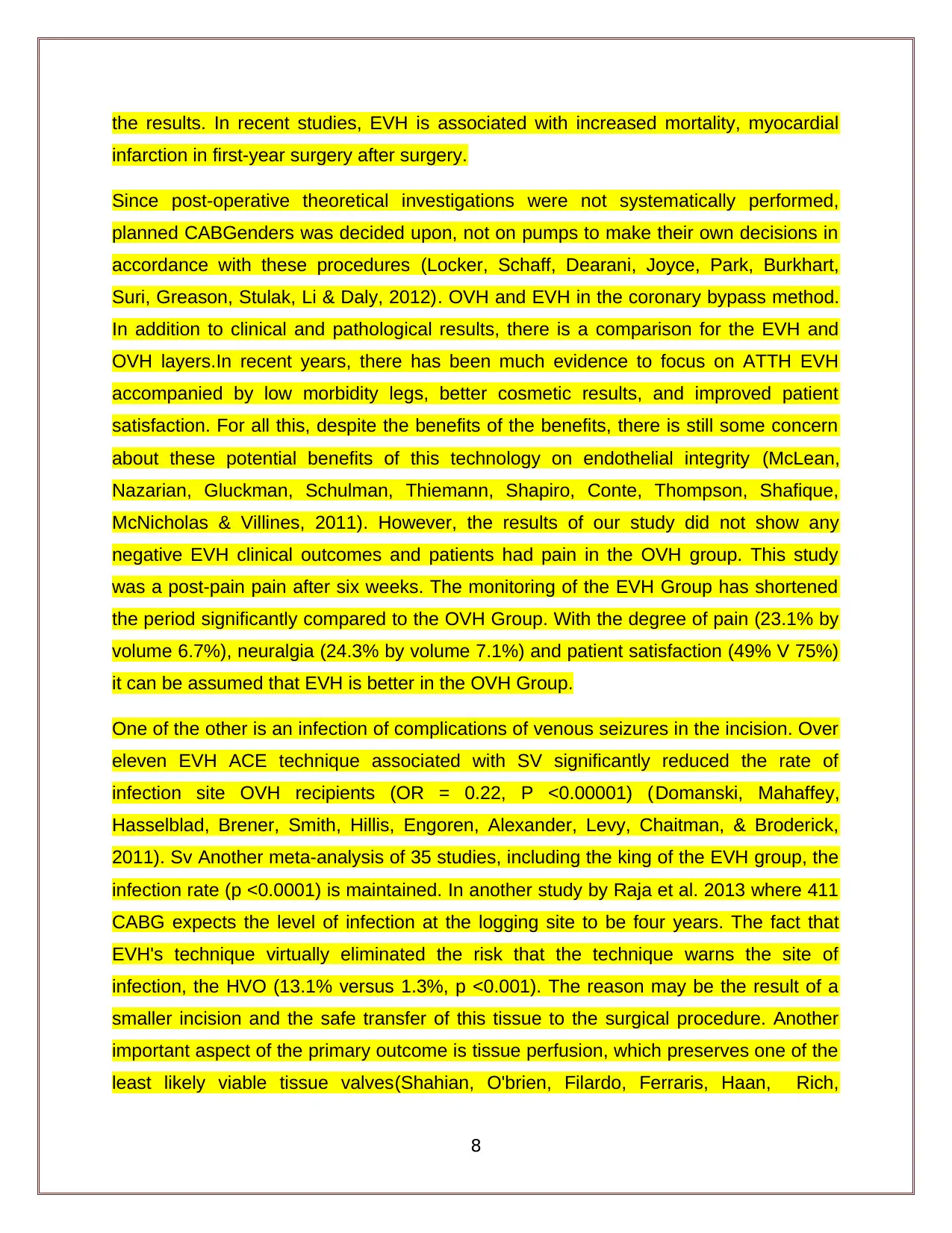
the results. In recent studies, EVH is associated with increased mortality, myocardial
infarction in first-year surgery after surgery.
Since post-operative theoretical investigations were not systematically performed,
planned CABGenders was decided upon, not on pumps to make their own decisions in
accordance with these procedures (Locker, Schaff, Dearani, Joyce, Park, Burkhart,
Suri, Greason, Stulak, Li & Daly, 2012). OVH and EVH in the coronary bypass method.
In addition to clinical and pathological results, there is a comparison for the EVH and
OVH layers.In recent years, there has been much evidence to focus on ATTH EVH
accompanied by low morbidity legs, better cosmetic results, and improved patient
satisfaction. For all this, despite the benefits of the benefits, there is still some concern
about these potential benefits of this technology on endothelial integrity (McLean,
Nazarian, Gluckman, Schulman, Thiemann, Shapiro, Conte, Thompson, Shafique,
McNicholas & Villines, 2011). However, the results of our study did not show any
negative EVH clinical outcomes and patients had pain in the OVH group. This study
was a post-pain pain after six weeks. The monitoring of the EVH Group has shortened
the period significantly compared to the OVH Group. With the degree of pain (23.1% by
volume 6.7%), neuralgia (24.3% by volume 7.1%) and patient satisfaction (49% V 75%)
it can be assumed that EVH is better in the OVH Group.
One of the other is an infection of complications of venous seizures in the incision. Over
eleven EVH ACE technique associated with SV significantly reduced the rate of
infection site OVH recipients (OR = 0.22, P <0.00001) (Domanski, Mahaffey,
Hasselblad, Brener, Smith, Hillis, Engoren, Alexander, Levy, Chaitman, & Broderick,
2011). Sv Another meta-analysis of 35 studies, including the king of the EVH group, the
infection rate (p <0.0001) is maintained. In another study by Raja et al. 2013 where 411
CABG expects the level of infection at the logging site to be four years. The fact that
EVH's technique virtually eliminated the risk that the technique warns the site of
infection, the HVO (13.1% versus 1.3%, p <0.001). The reason may be the result of a
smaller incision and the safe transfer of this tissue to the surgical procedure. Another
important aspect of the primary outcome is tissue perfusion, which preserves one of the
least likely viable tissue valves(Shahian, O'brien, Filardo, Ferraris, Haan, Rich,
8
infarction in first-year surgery after surgery.
Since post-operative theoretical investigations were not systematically performed,
planned CABGenders was decided upon, not on pumps to make their own decisions in
accordance with these procedures (Locker, Schaff, Dearani, Joyce, Park, Burkhart,
Suri, Greason, Stulak, Li & Daly, 2012). OVH and EVH in the coronary bypass method.
In addition to clinical and pathological results, there is a comparison for the EVH and
OVH layers.In recent years, there has been much evidence to focus on ATTH EVH
accompanied by low morbidity legs, better cosmetic results, and improved patient
satisfaction. For all this, despite the benefits of the benefits, there is still some concern
about these potential benefits of this technology on endothelial integrity (McLean,
Nazarian, Gluckman, Schulman, Thiemann, Shapiro, Conte, Thompson, Shafique,
McNicholas & Villines, 2011). However, the results of our study did not show any
negative EVH clinical outcomes and patients had pain in the OVH group. This study
was a post-pain pain after six weeks. The monitoring of the EVH Group has shortened
the period significantly compared to the OVH Group. With the degree of pain (23.1% by
volume 6.7%), neuralgia (24.3% by volume 7.1%) and patient satisfaction (49% V 75%)
it can be assumed that EVH is better in the OVH Group.
One of the other is an infection of complications of venous seizures in the incision. Over
eleven EVH ACE technique associated with SV significantly reduced the rate of
infection site OVH recipients (OR = 0.22, P <0.00001) (Domanski, Mahaffey,
Hasselblad, Brener, Smith, Hillis, Engoren, Alexander, Levy, Chaitman, & Broderick,
2011). Sv Another meta-analysis of 35 studies, including the king of the EVH group, the
infection rate (p <0.0001) is maintained. In another study by Raja et al. 2013 where 411
CABG expects the level of infection at the logging site to be four years. The fact that
EVH's technique virtually eliminated the risk that the technique warns the site of
infection, the HVO (13.1% versus 1.3%, p <0.001). The reason may be the result of a
smaller incision and the safe transfer of this tissue to the surgical procedure. Another
important aspect of the primary outcome is tissue perfusion, which preserves one of the
least likely viable tissue valves(Shahian, O'brien, Filardo, Ferraris, Haan, Rich,
8
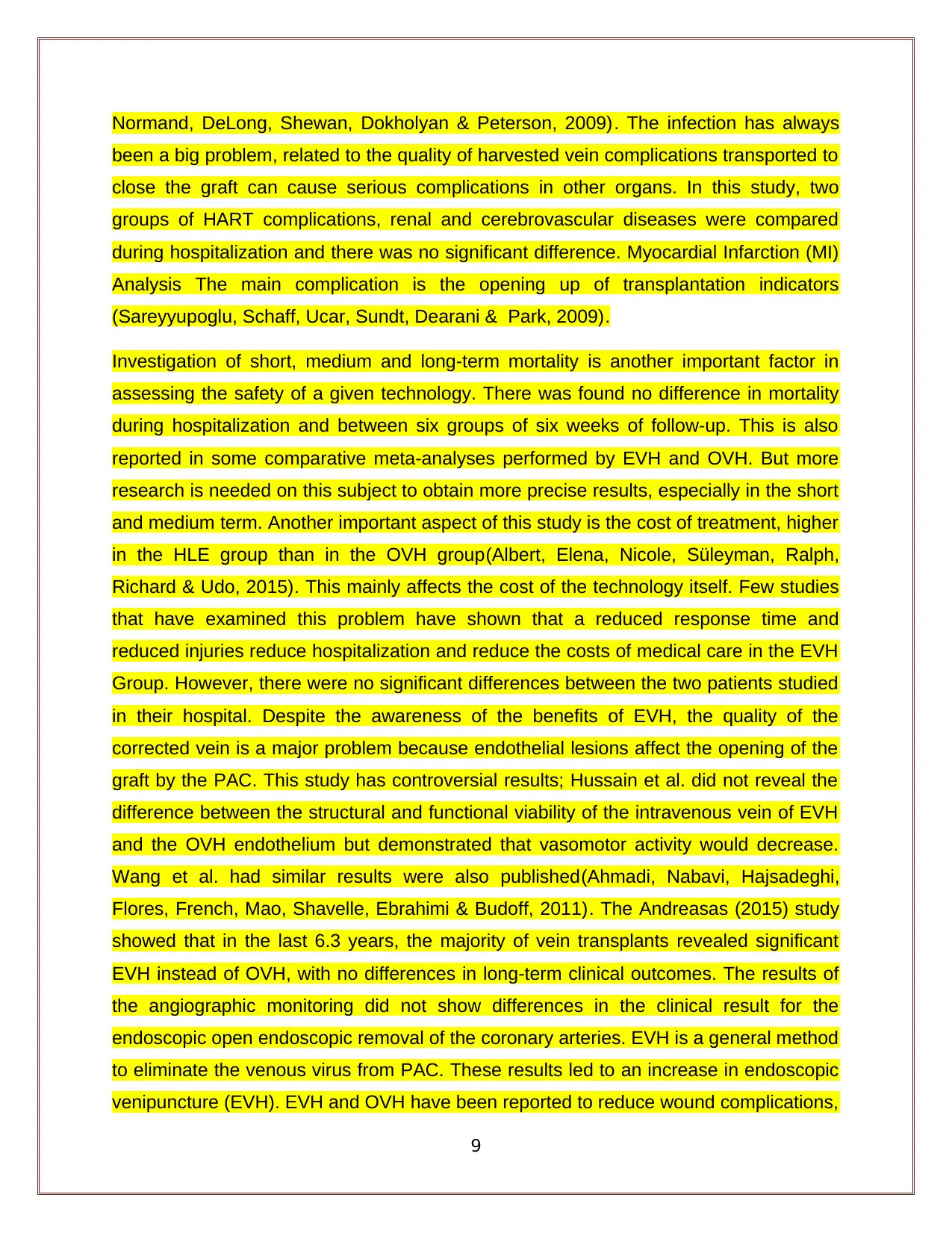
Normand, DeLong, Shewan, Dokholyan & Peterson, 2009). The infection has always
been a big problem, related to the quality of harvested vein complications transported to
close the graft can cause serious complications in other organs. In this study, two
groups of HART complications, renal and cerebrovascular diseases were compared
during hospitalization and there was no significant difference. Myocardial Infarction (MI)
Analysis The main complication is the opening up of transplantation indicators
(Sareyyupoglu, Schaff, Ucar, Sundt, Dearani & Park, 2009).
Investigation of short, medium and long-term mortality is another important factor in
assessing the safety of a given technology. There was found no difference in mortality
during hospitalization and between six groups of six weeks of follow-up. This is also
reported in some comparative meta-analyses performed by EVH and OVH. But more
research is needed on this subject to obtain more precise results, especially in the short
and medium term. Another important aspect of this study is the cost of treatment, higher
in the HLE group than in the OVH group(Albert, Elena, Nicole, Süleyman, Ralph,
Richard & Udo, 2015). This mainly affects the cost of the technology itself. Few studies
that have examined this problem have shown that a reduced response time and
reduced injuries reduce hospitalization and reduce the costs of medical care in the EVH
Group. However, there were no significant differences between the two patients studied
in their hospital. Despite the awareness of the benefits of EVH, the quality of the
corrected vein is a major problem because endothelial lesions affect the opening of the
graft by the PAC. This study has controversial results; Hussain et al. did not reveal the
difference between the structural and functional viability of the intravenous vein of EVH
and the OVH endothelium but demonstrated that vasomotor activity would decrease.
Wang et al. had similar results were also published(Ahmadi, Nabavi, Hajsadeghi,
Flores, French, Mao, Shavelle, Ebrahimi & Budoff, 2011). The Andreasas (2015) study
showed that in the last 6.3 years, the majority of vein transplants revealed significant
EVH instead of OVH, with no differences in long-term clinical outcomes. The results of
the angiographic monitoring did not show differences in the clinical result for the
endoscopic open endoscopic removal of the coronary arteries. EVH is a general method
to eliminate the venous virus from PAC. These results led to an increase in endoscopic
venipuncture (EVH). EVH and OVH have been reported to reduce wound complications,
9
been a big problem, related to the quality of harvested vein complications transported to
close the graft can cause serious complications in other organs. In this study, two
groups of HART complications, renal and cerebrovascular diseases were compared
during hospitalization and there was no significant difference. Myocardial Infarction (MI)
Analysis The main complication is the opening up of transplantation indicators
(Sareyyupoglu, Schaff, Ucar, Sundt, Dearani & Park, 2009).
Investigation of short, medium and long-term mortality is another important factor in
assessing the safety of a given technology. There was found no difference in mortality
during hospitalization and between six groups of six weeks of follow-up. This is also
reported in some comparative meta-analyses performed by EVH and OVH. But more
research is needed on this subject to obtain more precise results, especially in the short
and medium term. Another important aspect of this study is the cost of treatment, higher
in the HLE group than in the OVH group(Albert, Elena, Nicole, Süleyman, Ralph,
Richard & Udo, 2015). This mainly affects the cost of the technology itself. Few studies
that have examined this problem have shown that a reduced response time and
reduced injuries reduce hospitalization and reduce the costs of medical care in the EVH
Group. However, there were no significant differences between the two patients studied
in their hospital. Despite the awareness of the benefits of EVH, the quality of the
corrected vein is a major problem because endothelial lesions affect the opening of the
graft by the PAC. This study has controversial results; Hussain et al. did not reveal the
difference between the structural and functional viability of the intravenous vein of EVH
and the OVH endothelium but demonstrated that vasomotor activity would decrease.
Wang et al. had similar results were also published(Ahmadi, Nabavi, Hajsadeghi,
Flores, French, Mao, Shavelle, Ebrahimi & Budoff, 2011). The Andreasas (2015) study
showed that in the last 6.3 years, the majority of vein transplants revealed significant
EVH instead of OVH, with no differences in long-term clinical outcomes. The results of
the angiographic monitoring did not show differences in the clinical result for the
endoscopic open endoscopic removal of the coronary arteries. EVH is a general method
to eliminate the venous virus from PAC. These results led to an increase in endoscopic
venipuncture (EVH). EVH and OVH have been reported to reduce wound complications,
9
⊘ This is a preview!⊘
Do you want full access?
Subscribe today to unlock all pages.

Trusted by 1+ million students worldwide
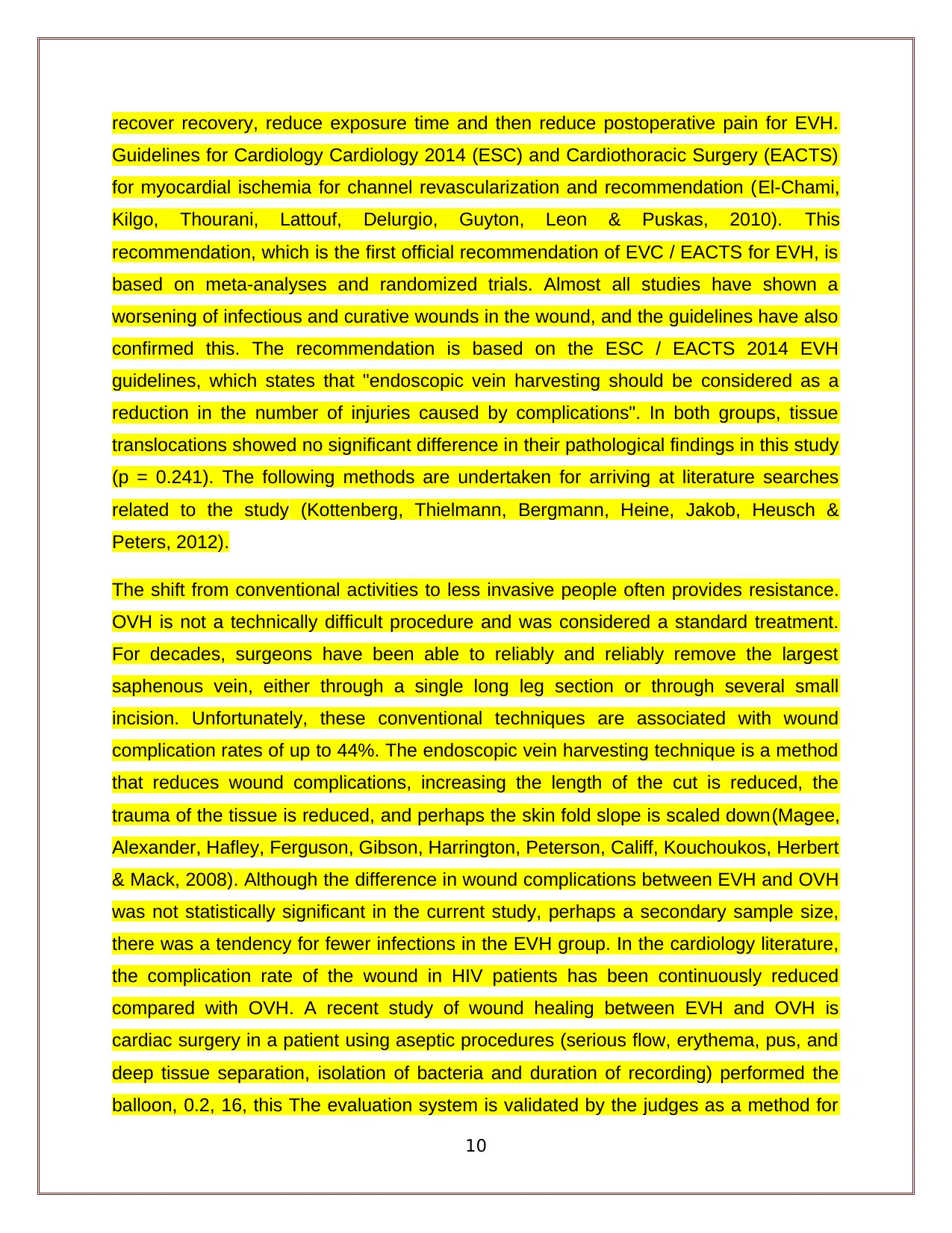
recover recovery, reduce exposure time and then reduce postoperative pain for EVH.
Guidelines for Cardiology Cardiology 2014 (ESC) and Cardiothoracic Surgery (EACTS)
for myocardial ischemia for channel revascularization and recommendation (El-Chami,
Kilgo, Thourani, Lattouf, Delurgio, Guyton, Leon & Puskas, 2010). This
recommendation, which is the first official recommendation of EVC / EACTS for EVH, is
based on meta-analyses and randomized trials. Almost all studies have shown a
worsening of infectious and curative wounds in the wound, and the guidelines have also
confirmed this. The recommendation is based on the ESC / EACTS 2014 EVH
guidelines, which states that "endoscopic vein harvesting should be considered as a
reduction in the number of injuries caused by complications". In both groups, tissue
translocations showed no significant difference in their pathological findings in this study
(p = 0.241). The following methods are undertaken for arriving at literature searches
related to the study (Kottenberg, Thielmann, Bergmann, Heine, Jakob, Heusch &
Peters, 2012).
The shift from conventional activities to less invasive people often provides resistance.
OVH is not a technically difficult procedure and was considered a standard treatment.
For decades, surgeons have been able to reliably and reliably remove the largest
saphenous vein, either through a single long leg section or through several small
incision. Unfortunately, these conventional techniques are associated with wound
complication rates of up to 44%. The endoscopic vein harvesting technique is a method
that reduces wound complications, increasing the length of the cut is reduced, the
trauma of the tissue is reduced, and perhaps the skin fold slope is scaled down(Magee,
Alexander, Hafley, Ferguson, Gibson, Harrington, Peterson, Califf, Kouchoukos, Herbert
& Mack, 2008). Although the difference in wound complications between EVH and OVH
was not statistically significant in the current study, perhaps a secondary sample size,
there was a tendency for fewer infections in the EVH group. In the cardiology literature,
the complication rate of the wound in HIV patients has been continuously reduced
compared with OVH. A recent study of wound healing between EVH and OVH is
cardiac surgery in a patient using aseptic procedures (serious flow, erythema, pus, and
deep tissue separation, isolation of bacteria and duration of recording) performed the
balloon, 0.2, 16, this The evaluation system is validated by the judges as a method for
10
Guidelines for Cardiology Cardiology 2014 (ESC) and Cardiothoracic Surgery (EACTS)
for myocardial ischemia for channel revascularization and recommendation (El-Chami,
Kilgo, Thourani, Lattouf, Delurgio, Guyton, Leon & Puskas, 2010). This
recommendation, which is the first official recommendation of EVC / EACTS for EVH, is
based on meta-analyses and randomized trials. Almost all studies have shown a
worsening of infectious and curative wounds in the wound, and the guidelines have also
confirmed this. The recommendation is based on the ESC / EACTS 2014 EVH
guidelines, which states that "endoscopic vein harvesting should be considered as a
reduction in the number of injuries caused by complications". In both groups, tissue
translocations showed no significant difference in their pathological findings in this study
(p = 0.241). The following methods are undertaken for arriving at literature searches
related to the study (Kottenberg, Thielmann, Bergmann, Heine, Jakob, Heusch &
Peters, 2012).
The shift from conventional activities to less invasive people often provides resistance.
OVH is not a technically difficult procedure and was considered a standard treatment.
For decades, surgeons have been able to reliably and reliably remove the largest
saphenous vein, either through a single long leg section or through several small
incision. Unfortunately, these conventional techniques are associated with wound
complication rates of up to 44%. The endoscopic vein harvesting technique is a method
that reduces wound complications, increasing the length of the cut is reduced, the
trauma of the tissue is reduced, and perhaps the skin fold slope is scaled down(Magee,
Alexander, Hafley, Ferguson, Gibson, Harrington, Peterson, Califf, Kouchoukos, Herbert
& Mack, 2008). Although the difference in wound complications between EVH and OVH
was not statistically significant in the current study, perhaps a secondary sample size,
there was a tendency for fewer infections in the EVH group. In the cardiology literature,
the complication rate of the wound in HIV patients has been continuously reduced
compared with OVH. A recent study of wound healing between EVH and OVH is
cardiac surgery in a patient using aseptic procedures (serious flow, erythema, pus, and
deep tissue separation, isolation of bacteria and duration of recording) performed the
balloon, 0.2, 16, this The evaluation system is validated by the judges as a method for
10
Paraphrase This Document
Need a fresh take? Get an instant paraphrase of this document with our AI Paraphraser
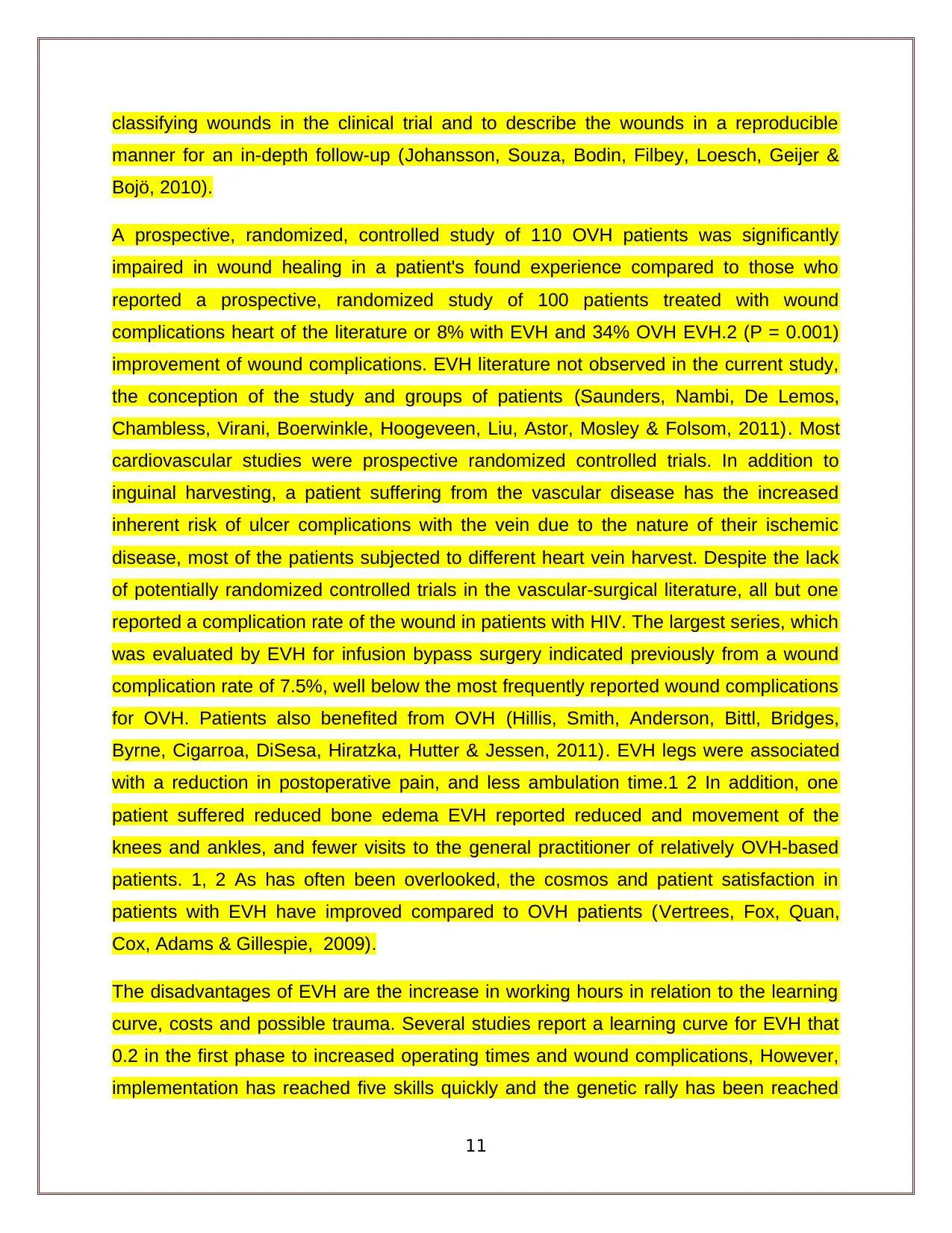
classifying wounds in the clinical trial and to describe the wounds in a reproducible
manner for an in-depth follow-up (Johansson, Souza, Bodin, Filbey, Loesch, Geijer &
Bojö, 2010).
A prospective, randomized, controlled study of 110 OVH patients was significantly
impaired in wound healing in a patient's found experience compared to those who
reported a prospective, randomized study of 100 patients treated with wound
complications heart of the literature or 8% with EVH and 34% OVH EVH.2 (P = 0.001)
improvement of wound complications. EVH literature not observed in the current study,
the conception of the study and groups of patients (Saunders, Nambi, De Lemos,
Chambless, Virani, Boerwinkle, Hoogeveen, Liu, Astor, Mosley & Folsom, 2011). Most
cardiovascular studies were prospective randomized controlled trials. In addition to
inguinal harvesting, a patient suffering from the vascular disease has the increased
inherent risk of ulcer complications with the vein due to the nature of their ischemic
disease, most of the patients subjected to different heart vein harvest. Despite the lack
of potentially randomized controlled trials in the vascular-surgical literature, all but one
reported a complication rate of the wound in patients with HIV. The largest series, which
was evaluated by EVH for infusion bypass surgery indicated previously from a wound
complication rate of 7.5%, well below the most frequently reported wound complications
for OVH. Patients also benefited from OVH (Hillis, Smith, Anderson, Bittl, Bridges,
Byrne, Cigarroa, DiSesa, Hiratzka, Hutter & Jessen, 2011). EVH legs were associated
with a reduction in postoperative pain, and less ambulation time.1 2 In addition, one
patient suffered reduced bone edema EVH reported reduced and movement of the
knees and ankles, and fewer visits to the general practitioner of relatively OVH-based
patients. 1, 2 As has often been overlooked, the cosmos and patient satisfaction in
patients with EVH have improved compared to OVH patients (Vertrees, Fox, Quan,
Cox, Adams & Gillespie, 2009).
The disadvantages of EVH are the increase in working hours in relation to the learning
curve, costs and possible trauma. Several studies report a learning curve for EVH that
0.2 in the first phase to increased operating times and wound complications, However,
implementation has reached five skills quickly and the genetic rally has been reached
11
manner for an in-depth follow-up (Johansson, Souza, Bodin, Filbey, Loesch, Geijer &
Bojö, 2010).
A prospective, randomized, controlled study of 110 OVH patients was significantly
impaired in wound healing in a patient's found experience compared to those who
reported a prospective, randomized study of 100 patients treated with wound
complications heart of the literature or 8% with EVH and 34% OVH EVH.2 (P = 0.001)
improvement of wound complications. EVH literature not observed in the current study,
the conception of the study and groups of patients (Saunders, Nambi, De Lemos,
Chambless, Virani, Boerwinkle, Hoogeveen, Liu, Astor, Mosley & Folsom, 2011). Most
cardiovascular studies were prospective randomized controlled trials. In addition to
inguinal harvesting, a patient suffering from the vascular disease has the increased
inherent risk of ulcer complications with the vein due to the nature of their ischemic
disease, most of the patients subjected to different heart vein harvest. Despite the lack
of potentially randomized controlled trials in the vascular-surgical literature, all but one
reported a complication rate of the wound in patients with HIV. The largest series, which
was evaluated by EVH for infusion bypass surgery indicated previously from a wound
complication rate of 7.5%, well below the most frequently reported wound complications
for OVH. Patients also benefited from OVH (Hillis, Smith, Anderson, Bittl, Bridges,
Byrne, Cigarroa, DiSesa, Hiratzka, Hutter & Jessen, 2011). EVH legs were associated
with a reduction in postoperative pain, and less ambulation time.1 2 In addition, one
patient suffered reduced bone edema EVH reported reduced and movement of the
knees and ankles, and fewer visits to the general practitioner of relatively OVH-based
patients. 1, 2 As has often been overlooked, the cosmos and patient satisfaction in
patients with EVH have improved compared to OVH patients (Vertrees, Fox, Quan,
Cox, Adams & Gillespie, 2009).
The disadvantages of EVH are the increase in working hours in relation to the learning
curve, costs and possible trauma. Several studies report a learning curve for EVH that
0.2 in the first phase to increased operating times and wound complications, However,
implementation has reached five skills quickly and the genetic rally has been reached
11
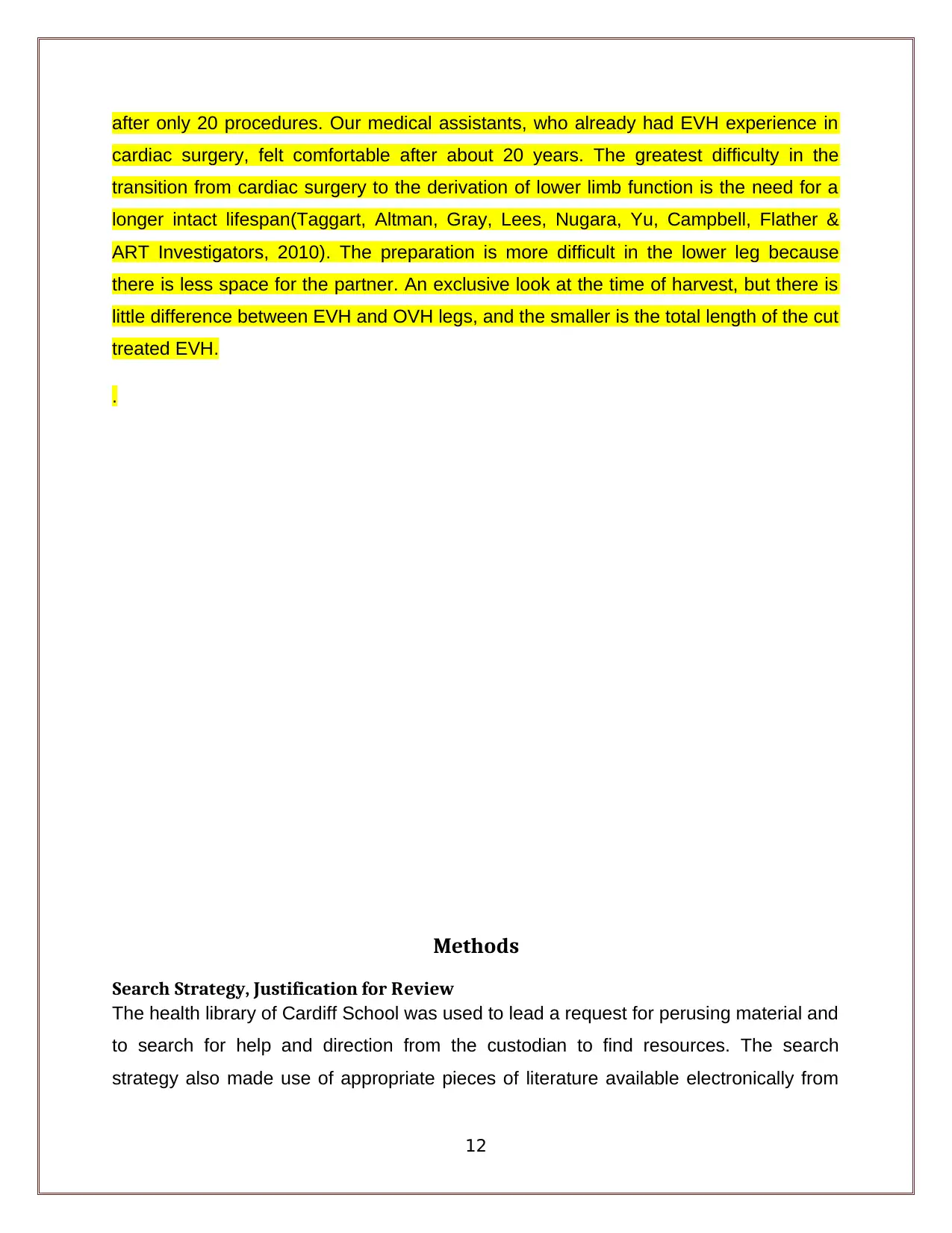
after only 20 procedures. Our medical assistants, who already had EVH experience in
cardiac surgery, felt comfortable after about 20 years. The greatest difficulty in the
transition from cardiac surgery to the derivation of lower limb function is the need for a
longer intact lifespan(Taggart, Altman, Gray, Lees, Nugara, Yu, Campbell, Flather &
ART Investigators, 2010). The preparation is more difficult in the lower leg because
there is less space for the partner. An exclusive look at the time of harvest, but there is
little difference between EVH and OVH legs, and the smaller is the total length of the cut
treated EVH.
.
Methods
Search Strategy, Justification for Review
The health library of Cardiff School was used to lead a request for perusing material and
to search for help and direction from the custodian to find resources. The search
strategy also made use of appropriate pieces of literature available electronically from
12
cardiac surgery, felt comfortable after about 20 years. The greatest difficulty in the
transition from cardiac surgery to the derivation of lower limb function is the need for a
longer intact lifespan(Taggart, Altman, Gray, Lees, Nugara, Yu, Campbell, Flather &
ART Investigators, 2010). The preparation is more difficult in the lower leg because
there is less space for the partner. An exclusive look at the time of harvest, but there is
little difference between EVH and OVH legs, and the smaller is the total length of the cut
treated EVH.
.
Methods
Search Strategy, Justification for Review
The health library of Cardiff School was used to lead a request for perusing material and
to search for help and direction from the custodian to find resources. The search
strategy also made use of appropriate pieces of literature available electronically from
12
⊘ This is a preview!⊘
Do you want full access?
Subscribe today to unlock all pages.

Trusted by 1+ million students worldwide
1 out of 45
Your All-in-One AI-Powered Toolkit for Academic Success.
+13062052269
info@desklib.com
Available 24*7 on WhatsApp / Email
![[object Object]](/_next/static/media/star-bottom.7253800d.svg)
Unlock your academic potential
Copyright © 2020–2025 A2Z Services. All Rights Reserved. Developed and managed by ZUCOL.

